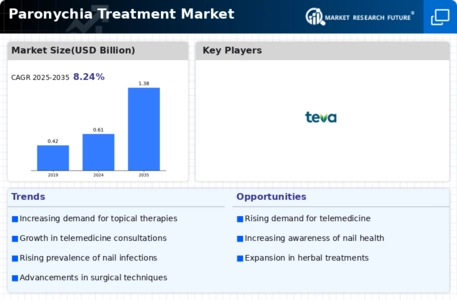Growing Geriatric Population
The aging population is a critical factor influencing the Paronychia Treatment Market. As individuals age, they often experience a decline in immune function and skin integrity, making them more susceptible to infections, including paronychia. The World Health Organization has projected a significant increase in the geriatric population, which is likely to result in a higher incidence of nail-related conditions. This demographic shift necessitates a greater focus on effective treatment options tailored to the needs of older adults. Consequently, healthcare providers may expand their services to address this growing demand, thereby driving growth in the Paronychia Treatment Market. Furthermore, the increased prevalence of comorbidities among the elderly may complicate treatment approaches, highlighting the need for specialized care and innovative solutions.
Rising Incidence of Paronychia
The increasing prevalence of paronychia is a notable driver in the Paronychia Treatment Market. Factors such as lifestyle changes, including increased nail grooming and exposure to irritants, contribute to this rise. According to recent data, the incidence of paronychia has been observed to increase, particularly among individuals engaged in occupations that involve frequent hand washing or exposure to chemicals. This trend necessitates a corresponding demand for effective treatment options, thereby propelling the market forward. As more individuals seek medical attention for this condition, healthcare providers are likely to expand their offerings, which could further stimulate growth in the Paronychia Treatment Market. The heightened awareness surrounding nail health and the potential complications associated with untreated paronychia also play a crucial role in driving market demand.
Increased Awareness of Nail Health
The growing awareness of nail health among the general population is a significant driver in the Paronychia Treatment Market. Educational campaigns and information dissemination through various media platforms have led to a better understanding of paronychia and its implications. As individuals become more informed about the symptoms and potential complications of untreated paronychia, they are more likely to seek timely medical intervention. This shift in consumer behavior is expected to increase the demand for treatment options, thereby benefiting the market. Additionally, healthcare professionals are increasingly emphasizing the importance of nail care, which may lead to a rise in preventive measures and early treatment, further propelling the Paronychia Treatment Market. The focus on holistic health and wellness also contributes to this trend, as individuals prioritize overall well-being.
Advancements in Treatment Modalities
Technological innovations in treatment modalities are significantly influencing the Paronychia Treatment Market. The development of new topical and systemic therapies, including antifungal and antibiotic agents, has enhanced treatment efficacy. Recent advancements in laser therapy and minimally invasive surgical techniques have also emerged as promising options for managing chronic paronychia. These innovations not only improve patient outcomes but also reduce recovery times, making them attractive to both patients and healthcare providers. As the medical community continues to explore and validate these new treatment options, the Paronychia Treatment Market is likely to experience a surge in demand. Furthermore, the integration of telemedicine in dermatological consultations allows for timely diagnosis and treatment recommendations, which could further enhance market growth.
Rising Demand for Home Care Solutions
The trend towards home care solutions is emerging as a notable driver in the Paronychia Treatment Market. With the increasing preference for self-management of health conditions, patients are seeking effective home-based treatments for paronychia. This shift is influenced by factors such as convenience, cost-effectiveness, and the desire for privacy in managing health issues. The availability of over-the-counter treatments and educational resources empowers patients to take proactive steps in addressing their condition. As a result, the market for home care solutions is likely to expand, offering a range of products designed for effective management of paronychia. This trend may also encourage manufacturers to innovate and develop new formulations that cater to the needs of consumers seeking home-based treatment options, thereby further stimulating the Paronychia Treatment Market.

















Leave a Comment